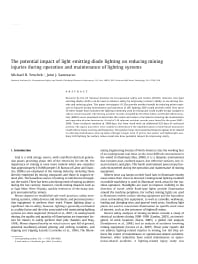Mining Publication: The Potential Impact of Light Emitting Diode Lighting on Reducing Mining Injuries During Operation and Maintenance of Lighting Systems
Original creation date: December 2010
Authors: MR Yenchek, JJ Sammarco
Research by the US National Institute for Occupational Safety and Health (NIOSH) indicates that light emitting diodes (LEDs) can be used to enhance safety by improving a miner’s ability to see mining hazards and reducing glare. This paper investigates if LEDs provide another benefit by reducing miner exposure to hazards during maintenance and operation of LED lighting. LEDs could provide useful lives up to 50 times longer than incandescent lighting commonly used in mining and could enable design changes to reduce certain hazards. The mining accident records compiled by the Mine Safety and Health Administration (MSHA) were examined to determine the extent and nature of accidents involving the maintenance and operation of mine luminaries. A total of 140 relevant accident records were found for the years 2002-2006. These incidents resulted in 3668 days lost from work with an additional 925 days of restricted activity. The injury narratives were studied to determine if the implementation of LED-based luminaries could reduce injury severity and frequency. The greatest near-term potential impacts appear to be related to reducing maintenance and cap lamp redesign. Longer term (5 years), low-power and lightweight auxiliary LED lighting for surface mines could also have potential impact for improving safety.

- An Analysis of Serious Injuries to Dozer Operators in the U.S. Mining Industry
- Computer Design and Evaluation Tool for Illuminating Underground Coal-Mining Equipment
- Crewstation Analysis Programs - An Easy to Use Personal Computer-based Lighting and Visibility Analysis Software Package for Underground Mining Equipment
- Evaluation of Mine Illumination Systems Using Numerical Modeling
- Evaluation of Visual Performance When Using Incandescent, Fluorescent, and LED Machine Lights In Mesopic Conditions
- Illumination
- LED Area Lighting to Reduce Glare for Roof Bolter Operators
- Maintainability
- Recommendations for Evaluating & Implementing Proximity Warning Systems on Surface Mining Equipment
- The Saturn LED Area Light Provides Improved Illumination for Greater Roof Bolter Safety
- Technology News 560 - The Saturn LED Area Light Provides Improved Illumination for Greater Roof Bolter Safety
- Underground Coal Mine Lighting Handbook (In Two Parts): 1. Background